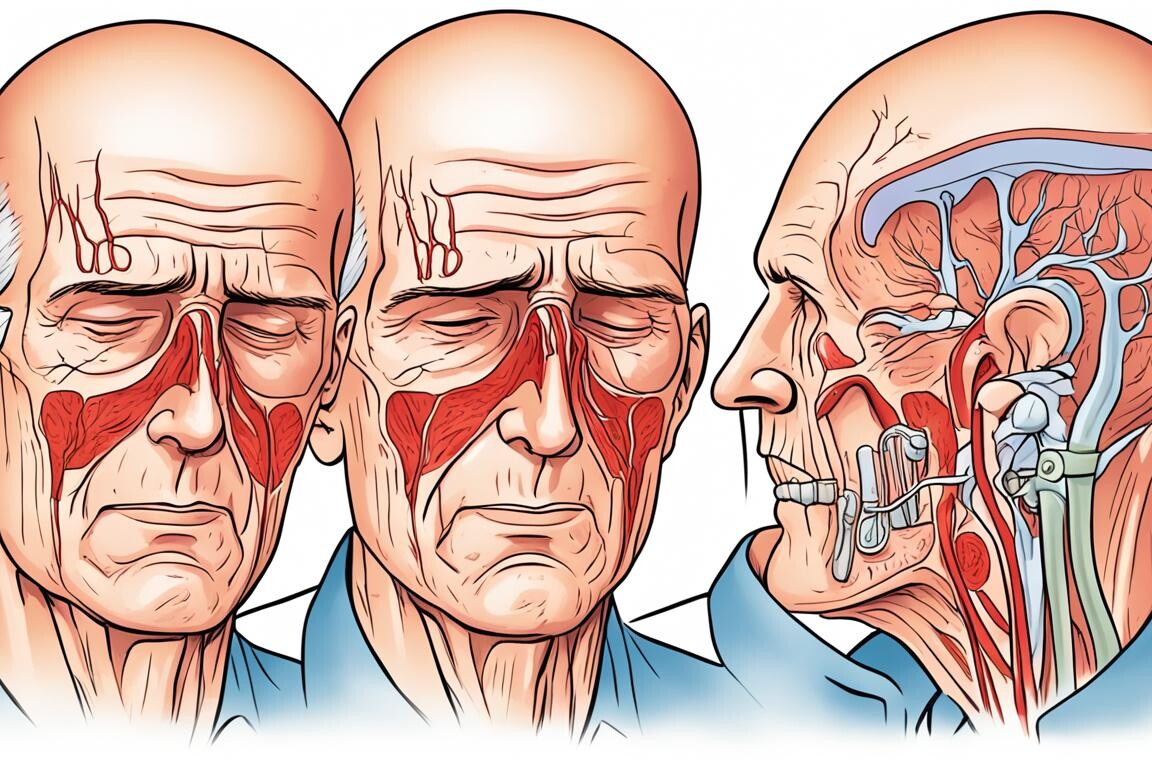Giant cell arteritis (GCA) is the most common vasculitis in adults. It causes inflammation of medium- to large-sized vessels and mainly affects older people. You might also hear it called temporal arteritis. Around 160,000 people in the U.S. have it, according to data from 2000.
If you see signs of giant cell arteritis in yourself or someone you know, act fast. This guide will cover what you need to know about its causes, symptoms, diagnosis, and how it’s treated. We aim to help you be informed and involved in your health care.
Table of Contents
ToggleUnderstanding Giant Cell Arteritis
Definition and Overview
Giant cell arteritis (GCA) is a common disease in adults. It causes swelling in the large arteries, mostly the temples. This problem is most likely to happen in older people.
History and Discovery
In the late 19th century, doctors first talked about giant cell arteritis. Since then, we have learned a lot about it. We know how it happens, what it looks like, and how to treat it.
This illness usually happens to those 50 and older. It’s more common in women. People from Northern Europe or Scandinavia often get it more. In these places, the rate of GCA is highest.
Many who have GCA also get another problem called polymyalgia rheumatica (PMR). PMR causes pain and stiffness near the shoulders and hips. Both illnesses are related, showing why it’s important to look at the big picture when treating them.
Epidemiology and Risk Factors
Giant cell arteritis (GCA) is a top systemic vasculitis in the U.S. It mainly affects adults. Learning about its epidemiology and risk factors helps us understand it better.
Age and Gender Distribution
People under 50 rarely get GCA. It becomes more common as people get older. GCA hits women more than men, with women affected 2 to 6 times more. This shows gender may play a role in getting GCA.
Racial and Ethnic Differences
Studies show GCA is more common in those of Scandinavian descent. Countries like Norway and Sweden have high GCA rates. But, the illness happens less in other ethnic groups. This hints that genes or the environment may also influence GCA development.
Other Risk Factors
Besides age and gender, GCA has other risks. Around 40% to 60% of GCA patients also have polymyalgia rheumatica. This condition often occurs together with GCA. Conversely, 16% to 21% of patients with polymyalgia might also get GCA. This shows a strong link between both illnesses.

What is giant cell arteritis
Causes and Etiology
The cause of giant cell arteritis (GCA) is not fully known. It includes a mix of genetic factors and environmental triggers. These lead to an odd immune reaction. Experts are working to find out more about what causes giant cell arteritis and its giant cell arteritis etiology.
Genetic Factors
Some genes might make people more likely to get GCA. Certain genes and HLA alleles could make someone prone to the disease. So, genetic factors in giant cell arteritis are important. Scientists are still looking into the DNA aspects of GCA.
Infectious and Environmental Triggers
Besides genes, things in the environment could also trigger GCA. Viruses, bacteria, and even exposure to some chemicals may be involved. This tells us that environmental triggers giant cell arteritis could be big factors. More research is being done to fully understand how these factors lead to GCA.
Pathophysiology and Disease Process
Giant cell arteritis (GCA) is caused by a mix of immune system action and issues in the arterial walls. This complex system leads to the growth and spread of this disease. It explains how GCA causes major problems for those affected.
Immune Response and Inflammation
GCA starts with two kinds of immune reactions. First, the body’s defense system goes into overdrive causing a widespread inflammation. The body makes lots of inflammatory substances like interleukin-6 and C-reactive protein. This makes you feel sick with fever, chills, and muscle pain, among other symptoms.
Arterial Wall Involvement
In GCA, the disease mainly impacts the walls of the blood vessels, especially the big ones like the temporal arteries. The issue inside these arteries involves a specific kind of inflammation with giant cells. This swelling can make the arteries hard and narrow, affecting blood flow. It’s why people with GCA often feel pain in their head, scalp, or jaw.
Symptoms and Clinical Presentation
Giant cell arteritis (GCA) shows different symptoms. They include issues with the eyes, the whole body, and big arteries. Knowing these signs is key to diagnosing and managing this problem early.
Ocular Manifestations
One big worry with GCA is losing your eyesight. This can happen because of a condition called AAION. People might see less clearly sometimes, get double vision, or go blind. Getting help right away if vision changes is very important. Without quick treatment, vision loss can be permanent.
Systemic Manifestations
Besides eye problems, GCA may cause issues across the body. These include headaches, pain in the scalp, trouble chewing, fever, feeling tired, losing weight, and muscle pain. These body-wide symptoms happen because of the body’s inflammation. They are vital clues to spotting GCA.
Large Artery Involvement
GCA can harm the body’s biggest arteries, like the aorta. This might cause problems like aortic aneurysm, which can be life-threatening if it bursts. While less common, GCA can also lead to a stroke. Studies show many GCA patients might have artery issues that aren’t causing symptoms yet. This is why full check-ups are important for everyone with GCA.
Diagnosis and Evaluation
The start of diagnosing giant cell arteritis (GCA) involves a full medical history and check-up. Patients often mention headaches, scalp and jaw pain, vision issues, and things like fever and weight loss. During a check-up, the doctor might find swollen or less pulse in the temples.
Diagnostic Tests
Your doctor might ask for a few tests to be sure about GCA. This could include:
- Erythrocyte sedimentation rate (ESR) and C-reactive protein (CRP) tests to check for body inflammation.
- Imaging scans like Doppler ultrasound, Magnetic resonance angiography (MRA), and Positron emission tomography (PET) to see your blood vessels’ state.
- A temporal artery biopsy, the top way to confirm GCA. This test takes a small artery piece to check for inflammation and giant cells under a microscope.
Differential Diagnosis
Figuring out GCA is tough because its signs are like other sicknesses. The doctor works to exclude things like infections, migraines, and other blood vessel conditions.
Getting a clear diagnosis matters to start care fast and avoid bad outcomes, like losing sight. You might see more doctors, such as eye or nerve specialists, or those who study joint problems to plan your treatment.

Treatment and Management
The giant cell arteritis treatment is quick, strong steroid therapy. Giving prednisone or methylprednisolone early is key. It calms the immune system, stopping the swelling in blood vessels that can hurt eyesight.
Corticosteroid Therapy
Prednisone at 40 to 60 mg daily is the top choice for treating GCA. Doctors may raise this up to 80 mg a day if needed to control symptoms. They avoid starting with less than 40 mg to make sure it’s effective.
New Treatment Strategies
Experts also look at new ways to treat GCA. Methotrexate and a drug called tocilizumab (Actemra) are two options. Methotrexate might help with lessening the need for high steroid doses. Tocilizumab is a newer drug specifically for GCA.
Follow-up and Monitoring
After starting treatment, regular check-ups are vital. Tests on blood like ESR and CRP reflect how well the treatment’s working. Adding calcium and vitamin D helps prevent bone problems from steroids.
Conclusion
In conclusion, giant cell arteritis is the top primary vasculitis affecting adults. It strikes about 10 out of every 100,000 people. This disease causes inflammation in the blood vessels. It mainly attacks the temporal arteries, posing serious health risks. Elderly individuals, especially northern European women, face a higher risk.
This detailed look at giant cell arteritis shows its danger. It can make 30% of those affected lose their vision. About 2% of patients die from it. Risk factors include having PMR, being over 50, and having European roots.
It’s critical to know the signs, reasons, and how to deal with giant cell arteritis. Early diagnosis and treatment can prevent severe outcomes, like blindness. Understanding and reacting quickly to its symptoms offer the best hope for recovery.
FAQ
What is giant cell arteritis?
Giant cell arteritis (GCA) is a frequent type of vasculitis in adults. It brings about general inflammation in the body’s medium to large vessels. especially the temporal arteries. On another note, it’s called temporal arteritis as well.
What are the causes and risk factors for giant cell arteritis?
The reasons behind GCA are not simple. They mix genetic traits with possible infections or environmental causes. These factors start an immune reaction. This disorder often hits older people. Plus, it’s more common in women and those of northern European heritage.
What are the symptoms of giant cell arteritis?
Signs of GCA are quite clear. They include a headache, pain when touching the scalp, and jaw discomfort. Changes in sight are also common, along with general symptoms like fever, chills, and weight loss. The worst part is the risk of losing your vision because of a condition called arteritic anterior ischemic optic neuropathy (AAION).
How is giant cell arteritis diagnosed?
Doctors start diagnosing GCA with a careful look back on your health and physical checks. They’ll also do some tests, looking for signs of inflammation. And they might suggest images to help confirm the diagnosis and eliminate other possible issues.
How is giant cell arteritis treated?
Treating GCA quickly is very important. It involves high doses of steroids, often prednisone or methylprednisolone. This kind of treatment prevents serious problems like blindness. Doctors are also looking at new ways to treat GCA, like using biologics.
Source Links
- https://www.niams.nih.gov/health-topics/polymyalgia-rheumatica-giant-cell-arteritis
- https://www.ncbi.nlm.nih.gov/pmc/articles/PMC3679627/
- https://www.mayoclinic.org/diseases-conditions/giant-cell-arteritis/symptoms-causes/syc-20372758
- https://www.ncbi.nlm.nih.gov/books/NBK459376/
- https://versusarthritis.org/about-arthritis/conditions/giant-cell-arteritis-gca/
- https://emedicine.medscape.com/article/332483-overview
- https://rheumatology.org/patients/giant-cell-arteritis
- https://www.arthritis.org/diseases/giant-cell-arteritis
- https://www.uptodate.com/contents/clinical-manifestations-of-giant-cell-arteritis
- https://www.mayoclinic.org/diseases-conditions/giant-cell-arteritis/diagnosis-treatment/drc-20372764
- https://www.uptodate.com/contents/diagnosis-of-giant-cell-arteritis
- https://www.uptodate.com/contents/treatment-of-giant-cell-arteritis
- https://myacare.com/blog/what-is-giant-cell-arteritis
About The Author

This article is medically reviewed by Dr. Chandril Chugh, Board-Certified Neurologist, providing expert insights and reliable health information.
Dr. Chandril Chugh is a U.S.-trained neurologist with over a decade of experience. Known for his compassionate care, he specializes in treating neurological conditions such as migraines, epilepsy, and Parkinson’s disease. Dr. Chugh is highly regarded for his patient-centered approach and dedication to providing personalized care.
→ Book a consultation to discover which remedies suit your needs best.




